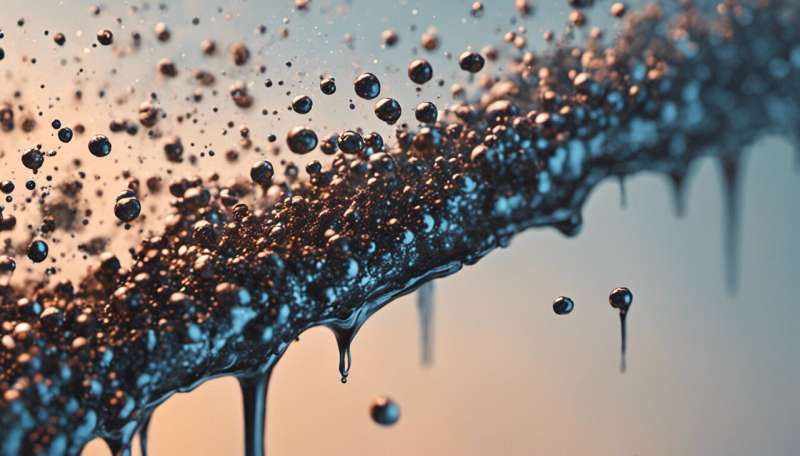Researchers develop a way to better predict corrosion from crude oil

Using X-ray techniques, scientists are developing an analysis tool that can more accurately predict how sulfur compounds in a batch of crude oil might corrode equipment– an important safety issue for the oil industry.
The results of these ongoing experiments at the Stanford Synchrotron Radiation Lightsource (SSRL) at the Department of Energy's SLAC National Accelerator Laboratory will improve industry guidelines. The goal is to characterize the types of sulfur that are most critical to identify in the oil, in order to better anticipate the potential for corrosion rates.
A team of researchers from Chevron and the University of Saskatchewan are performing a series of studies at SSRL to closely examine forms of sulfur in crude oil.
"By looking at crude oil with a combination of X-ray spectroscopy techniques, we were able to examine and describe the complex chemistry of the sulfur compounds with high specificity," said Monica Barney, a materials research engineer at Chevron.
Complexities in the Data
Nearly a million barrels of oil are processed on a given day at Chevron's major refineries throughout the United States, and the sulfur present in the oil can react with the metals in various types of equipment and cause damage. These reactions are something engineers must consider to ensure safe and reliable processing.
But high sulfur concentrations don't always correlate with high levels of corrosion, or the other way around, and this makes it difficult to anticipate how corrosive a particular crude oil will be.
"We can measure the concentration of sulfur, but it doesn't tell you about the reactivity," says Barney, who is leading the studies. "Knowing the type of sulfur in crude oil is critically important for predicting properties related to corrosion."
The collaboration began when Barney was working on a separate corrosion study at SSRL. After collecting the data, the Chevron team was struggling with how to interpret the complexities they saw in the results.
In an online search, they came across a diagram developed by two professors at the University of Saskatchewan, Graham George and Ingrid Pickering, while they were on the staff at SSRL. They have conducted molecular biology and toxicology experiments at the SSRL synchrotron for years.
The diagram showed spectroscopy information gathered from the superimposition of data on many sulfur types, similar to what's seen in crude oil. It showed how comparing an overall spectrum to a library of standards could identify individual types of compounds.
"When I came across this figure, I thought, 'This is it. This is what we need.' It's what we'd been seeking for years—a characterization method that could quantify the amounts of each type of sulfur," Barney says.
The idea was to use the same technique—sulfur K-edge X-ray absorption spectroscopy—to measure and determine the types of sulfur in crude oils.
Barney soon began collaborating with George and Pickering to find a solution. Both worked previously in the oil and gas industry, and Barney says their expertise was a perfect match with what Chevron wanted to study.
With this analysis method, the team developed an approach to examining the crude oil with "tender X-rays," which occupy the middle ground between high-energy and low-energy X-rays.
Tuned to the correct energy, X-rays allowed the researchers to collect detailed information about the sulfur and its chemical neighbors and help tease through the overlapping information generated by similarities in the sulfur compounds.
Understanding Sulfur Chemistry
The large number of various sulfur compounds present in the crude oil, each subtly different from the others, makes the results from most types of characterization techniques difficult to interpret or even inconclusive.
The X-ray absorption spectroscopy work at SSRL allows the scientists to see a precise description of the crude oil's sulfur chemistry.
"This is an example of using state-of-the-art spectroscopy for a real-world application," George says.
This work is part of a larger collaboration at Chevron that is using several other techniques to understand the chemistry of sulfur in crude oil. The experimental data from several chemical characterization methods are combined and compared to data from corrosion studies and predictions from computer modeling.
More information: Julien J. H. Cotelesage et al. Insights into the Nature of the Chemical Bonding in Thiophene-2-thiol from X-ray Absorption Spectroscopy, The Journal of Physical Chemistry A (2016). DOI: 10.1021/acs.jpca.6b05874
Ingrid J. Pickering et al. Chemical Sensitivity of the Sulfur K-Edge X-ray Absorption Spectra of Organic Disulfides, The Journal of Physical Chemistry A (2016). DOI: 10.1021/acs.jpca.6b06790
Provided by SLAC National Accelerator Laboratory



















